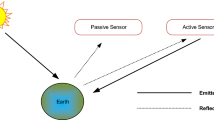Abstract
Sensor networks are envisioned to revolutionize our daily life by ubiquitously monitoring our environment and/or adjusting it to suit our needs. Recent progress in robotics and low-power embedded systems has made it possible to add mobility to small, light, low-cost sensors to be used in teams or swarms. Augmenting static sensor networks with mobile nodes addresses many design challenges that exist in traditional static sensor networks. This paper addresses the problem of topology control in mobile wireless networks. Limitations in communication, computation and energy capabilities push towards the adoption of distributed, energy-efficient solutions to perform self-deployment and relocation of the nodes. We develop a unified, distributed algorithm that has the following features. During deployment, our algorithm yields a regular tessellation of the geographical area with a given node density, called monitoring configuration. Upon the occurrence of a physical phenomenon, network nodes relocate themselves so as to properly sample and control the event, while maintaining the network connectivity. Then, as soon as the event ends, all nodes return to the monitoring configuration. To achieve these goals, we use a virtual force-based strategy which proves to be very effective even when compared to an optimal centralized solution. We assess the performance of our approach in the presence of events with different shapes, and we investigate the transient behavior of our algorithm. This allows us to evaluate the effectiveness and the response time of the proposed solution under various environmental conditions.
Similar content being viewed by others
References
Bokser V, Oberg C, Sukhatme G, Requicha A. A small submarine robot for experiments in underwater sensor networks. In Proc. 5th Symposium on Intelligent Autonomous Vehicles, Lisbon, Portugal, July 2004.
Sub-kilogram intelligent tele-robots (SKIT). http://www-robotics.usc.edu/∼behar/SKIT.html.
Sandia national laboratories. http://www.sandia.gov/media/NewsRel/NR2001/minirobot.htm.
Akyildiz I F, Kasimoglu I H. Wireless sensor and actor networks: Research challenges. Ad Hoc Networks Journal, Oct. 2004, 2(4): 351–367.
GPS receiver for outdoor use. http://forestry.about.com/od/mappinggis/p/GPS_essentials.htm.
Wang G, Cao G, La Porta T F. Movement-assisted sensor deployment. IEEE Trans. Mobile Computing, June 2006, 5(6): 640–652.
Butler Z, Rus D. Event-based motion control for mobile sensor networks. IEEE Pervasive Computing, 2003, 2(4): 10–18.
Wang G, Cao G, La Porta T F, Zhang W. Sensor relocation in mobile sensor networks. In INFOCOM’05, Miami, FL, Mar. 2005, pp.2302–2312.
Li X, Santoro N, Stojmenovic I. Mesh-based sensor relocation for coverage maintenance in mobile sensor networks. In Proc. Ubiquitous Intelligence and Computing, Hong Kong, China, July 2007.
Bonabeau E, Dorigo M, Theraulaz G. Swarm Intelligence: From Natural to Artificial Systems. Oxford University Press, 1999.
Zou Y, Chakrabarty K. Sensor deployment and target localization based on virtual forces. In Proc. INFOCOM’03, Mar.-Apr. 2003, pp.1293–1303.
Heo N, Varshney P K. Energy-efficient deployment of intelligent mobile sensor networks. IEEE Trans. Systems, Man, and Cybernetics, Part A, Jan. 2005, 35(1): 78–92.
Wong T, Tsuchiya T, Kikuno T. A self-organizing technique for sensor placement in wireless micro-sensor networks. In Proc. 18th International Conference on Advanced Information Networking and Application (AINA’04), Fukoka, Japan, 2004, pp.78–83.
Howard A, Matarić M J, Sukhatme G S. Mobile sensor network deployment using potential fields: A distributed, scalable solution to the area coverage problem. In Proc. 6th International Symposium on Distributed Autonomous Robotics Systems (DARS’02), Fukuoka, Japan, June 2002, pp.299–308.
Wu J, Yang S. SMART: A scan-based movement-assisted sensor deployment method in wireless sensor networks. In Proc. INFOCOM’05, Miami, FL, Mar. 2005, pp.2313–2324.
Bai X, Kumar S, Xuan D, Yun Z, Lai T H. Deploying wireless sensors to achieve both coverage and connectivity. In Proc. MobiHoc’06, Florence, Italy, May 2006, pp.131–142.
Liu B, Towsley D. A study of the coverage of large-scale sensor networks. In Proc. 1st IEEE International Conference on Mobile Ad-hoc and Sensor Systems (MASS’04), Fort Lauderdale, FL, Oct. 2004.
Tipler P. Physics for Scientists and Engineers. Vol. 1, 4th ed., W.H. Freeman, 1998.
O’Dwyer A. Handbook of PI and PID Controller Tuning Rules. London: Imperial College Press, 2006.
Krim J, Viberg M. Two decades of array signal processing research. The parametric approach. IEEE Signal Proc. Mag., July 1996, 13: 57–64.
Animated graphs. http://www.telematica.polito.it/∼garetto/sensors/
Ohta T, Sugano M, Murata M. Autonomous localization method in wireless sensor networks. In Proc. Third IEEE International Conference on Pervasive Computing and Communications (PerCom’05), Kauai Island, HI, USA, Mar. 2005, pp.379–384.
Author information
Authors and Affiliations
Corresponding author
Additional information
This work is supported by the Italian Ministry for Scientific Research (MIUR), through the MEADOW project.
Rights and permissions
About this article
Cite this article
Garetto, M., Gribaudo, M., Chiasserini, CF. et al. Sensor Deployment and Relocation: A Unified Scheme. J. Comput. Sci. Technol. 23, 400–412 (2008). https://doi.org/10.1007/s11390-008-9142-y
Revised:
Published:
Issue Date:
DOI: https://doi.org/10.1007/s11390-008-9142-y




